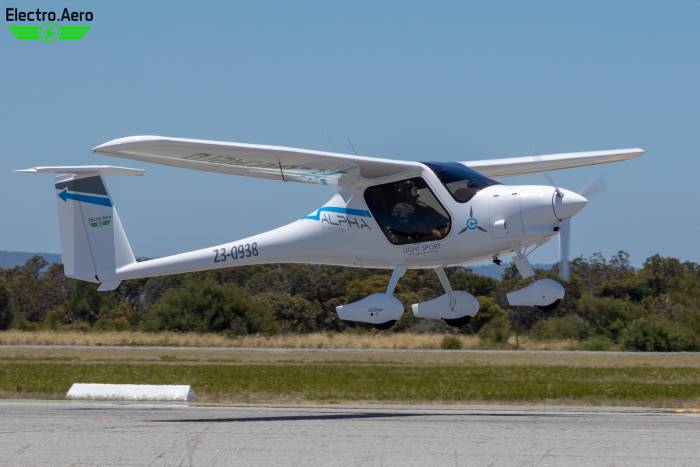Last week reportedly saw the first time a certified electric aircraft has flown in Australia – a Pipistrel Alpha Electro owned by Electro.Aero that successfully completed test flights in Perth.
The Pipistrel Alpha Electro is a two-seat light sport aircraft closely based on the Pipistrel Alpha petrol-engine trainer. Weighing just 350 kilograms including its lithium-ion batteries, the plane can carry a payload of 200 kilograms. It has a flight time of 60 minutes, plus reserve, and is able to take off at full maximum weight with a run of just 150 metres.
Its range at a cruising speed of 85 knots (157 km/h) is 120 kilometres, including take-off and landing. Recharging the 21 kilowatt-hour battery pack using a “supercharger” only takes an hour.
Alpha Electro has a 60kW outrunner type electric motor providing direct-drive to the three-blade 1.65 metre diameter propeller. Motor and inverter cooling is provided by a fluid based system (50% anti-freeze and 50% water) and radiator.
Alpha Electro’s energy storage is contained in two boxes that house the battery cells, battery management systems and communication modules, power and signal connectors. The plane will function with only one of the battery boxes connected, but with substantially reduced performance. In the case of failure of one battery box, the system will automatically switch to a single-battery mode.
In the hopefully unlikely event of things going even more pear-shaped and a battery system fire occurring, the manual for the Pipistrel Alpha Electro offers this handy tip:
“Land and leave the aircraft as soon as possible.”
As with fossil fuels, once lithium-ion batteries are on fire, it’s best to skedaddle.
In addition to being emissions-free (assuming renewables- based charging) and cheaper to operate, the Pipistrel Alpha Electro is very quiet.
“This is the start of the next revolution in general aviation,” said Electro.Aero Finance Director, Richard Charlton. “We are already fielding enquiries from airports located in major cities where noise complaints have become their number one concern.”
ABC reports the plane may be used for flights to Rottnest Island soon and discussions have been held with Rottnest Island Authority regarding potentially installing a supercharger on the island to draw from Rottnest’s solar array. The Rottnest Wind Turbine, which has its own Twitter account, may be feeling a little left out; but is yet to comment on the proposal.
Rottnest Island’s solar farm is a 600kW installation featuring 8,000 solar panels that feed electricity into the island’s grid. Between solar power and Rottnest’s wind turbine, renewables now account for 45 per cent of the island’s energy production.


 RSS - Posts
RSS - Posts



While batteries don’t come close to the specific energy of the kerosene used in conventional planes, where electric flight really shines is in the reduction in maintenance and engine overhaul/replacement costs which can be around $40 an hour for a 2 seat conventional plane.
In the linked ABC news report, is
“The plane uses 60 kilowatts of power to take off and 20kW to cruise.
But once it is gliding, the motor switches off ”
I think that might be unsettling, when it goes into stealth mode.
It reminds me of a previous aircraft model – I believe that it was known as V-1, and, when it went quiet, it was time to fear.
Similarly, if a modern aircraft was flying in my direction, or, if I would be in a modern aircraft, and its engines suddenly went quiet, I would become a bit concerned, I think.
Gravity is a law that is still to difficult to break.